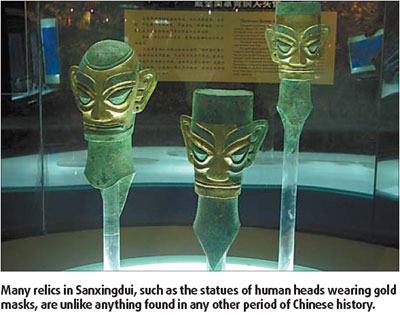One of the more impressive displays at the Sanxingdui Museum, in Guanghan of Southwest China's Sichuan Province, is a bronze statue of a barefoot man with anklets and clenched hands.
The 2.62-meter-high, 180-kilogram statue is thought to represent a king of the Shu Kingdom. Shu was the name for Sichuan in ancient times.
Dating back 3,100 years, the king's statue is crowned with a sun motif and coated with three layers of tight, short sleeved bronze "clothing", which is decorated with a dragon pattern and overlaid with a checked ribbon.
Huang Nengfu, a professor of arts and design at Tsinghua University and an eminent researcher in Chinese clothing from different dynasties, considers the garment to be the country's oldest existing dragon robe. He also thinks that the pattern is the work of the famous Shu Embroidery.
The robe has changed the traditional view that Shu Embroidery began in the mid-Qing Dynasty (1644-1911). Instead, it shows Shu Embroidery appeared in the Shang Dynasty (c.16th century-c.11th century BC), according to Wang Yuqing, a Taiwan-based Chinese clothing historian.
The bronze statue of the Shu king is one of the four most important cultural relics to be found in the Sanxingdui Ruins in Guanghan, a city 40 kilometers from Chengdu.
Sanxingdui, which means "three star mounds" in English, is so named because the ruins are located in a village where there are three mounds.
Since 1929, more than 10,000 relics, dating between 5,000 and 3,000 years ago have been unearthed in the city's Sanxingdui Ruins. The excavations have yielded some of the most significant Chinese archaeological discoveries of the 20th century.
Archaeologists around the world were excited by the unearthing of large palatial remains in 1980, the remnants of eastern, western and southern walls in 1984 and the discovery of two large sacrificial pits in 1986.
These discoveries proved that Sanxingdui contains the ruins of an ancient city that was the political, economic and cultural center of the ancient Shu Kingdom.
A metropolis of its time, Sanxingdui boasted highly developed agricultural and mining systems, and produced ceramics and sacrificial tools.
Before the excavation of Sanxingdui, it was believed that Sichuan had a history dating back 3,000 years. Thanks to the excavation, it is now believed that civilized culture first appeared in Sichuan 5,000 years ago.
Archaeologists say that the Sanxingdui Ruins also dispel theories that the Yellow River was the sole starting point of Chinese civilization.
Of more than 10,000 relics unearthed in Sanxingdui, the nearly 1,000 found in 1986 in the two sacrificial pits are considered the most valuable. In these two pits, bronze, gold, jade and marble artifacts, pottery, bone implements, elephant tusks and objects made of ivory were found. Archaeologists also discovered cowries and roughly 800 large bronze relics.
In addition to the many bronze and gold masks, the most valuable finds from the two pits included the bronze statue of the Shu king, a gold scepter and a bronze "spirit tree".
With a length of 1.42 meters, a diameter of 2.3 centimeters and a weight of 0.5 kilograms, the design on the gold scepter features fish, birds and human figures. The scepter is believed to be a symbol for a monarchic or theocratic order, or a combination of the two.
Consisting of a pedestal, a trunk and part of a dragon, the 3.95-meter-tall bronze tree is the oldest, tallest and largest of its kind in the world. Some think that it represents a legendary spirit tree, while many researchers believe that the tree was an all-embracing symbol.
Many theories also surround the fall of the Sanxingdui civilization, which seemingly disappeared without a trace, leaving behind objects unlike anything found in any other period of Chinese history.
Archaeologists have been left wondering what the purpose of the objects was and how such an ancient culture, at the very beginning of Chinese civilization, could be so advanced.
Some speculate that aliens might be behind the mysterious relics after locals in the area alleged that they spotted UFOs in the area 20 years ago.
The Sanxingdui Ruins cover 12 square kilometers, of which only four have been excavated. Chen Xiandan, deputy curator of the Sichuan Provincial Museum says: "It is likely that more exciting archaeological discoveries will be made."
(China Daily November 1, 2007)






